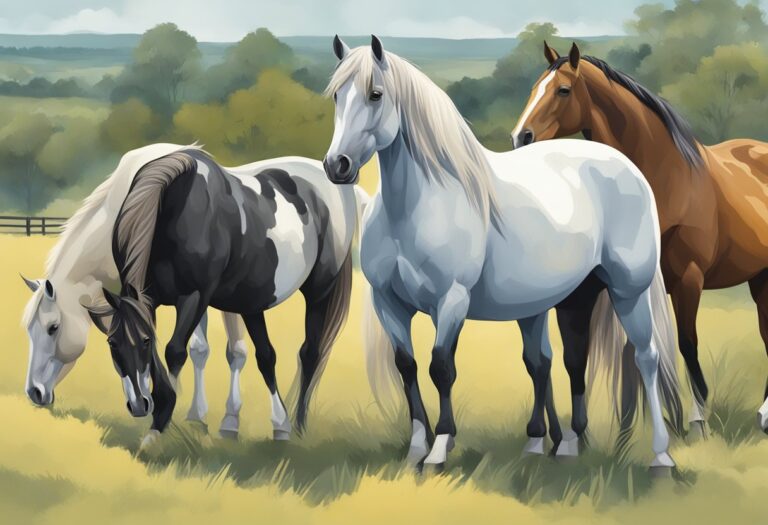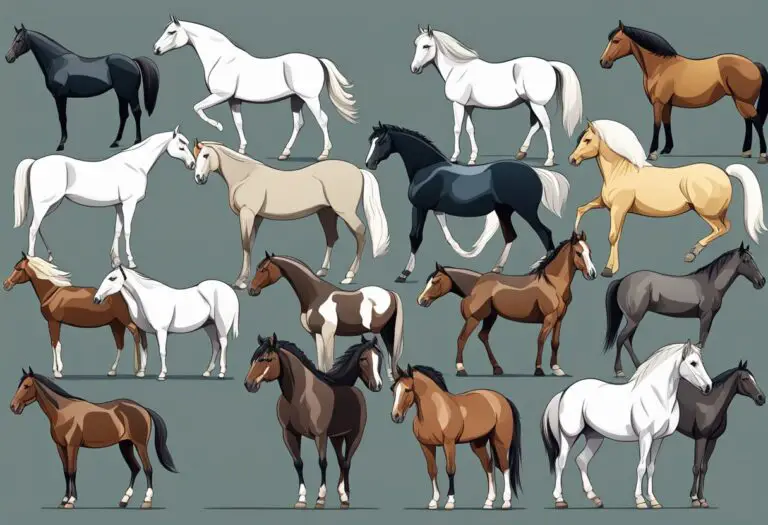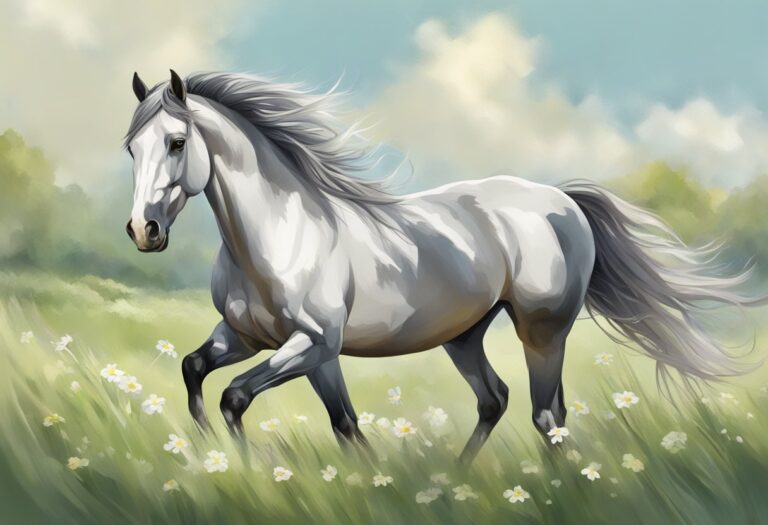How to Identify Horse Breeds? A Clear Guide for Horse Enthusiasts
Identifying horse breeds can be a daunting task, especially for those who are new to the equine world. However, with a little bit of knowledge and practice, anyone can learn to identify different horse breeds. Whether you’re a horse enthusiast, a veterinarian, or simply curious about different horse breeds, this article will provide you with the basics of how to identify them.
One of the first things to look for when identifying horse breeds is their physical appearance. Different breeds have distinct physical characteristics, such as their size, color, and body shape. For example, the Arabian horse is known for its distinctive head shape and high-set tail, while the Thoroughbred is known for its tall and lean build.
Another important factor to consider when identifying horse breeds is their history and origin. Many horse breeds have unique histories that have shaped their physical characteristics and temperament. Learning about a breed’s history can help you better understand their traits and behaviors, which can in turn help you identify them more easily.
Understanding Horse Breeds

Horses come in a variety of breeds, each with its unique characteristics and traits. Understanding horse breeds is essential for horse lovers, breeders, and riders alike. Here are some key points to help you identify horse breeds:
Physical Characteristics
Physical characteristics are the most apparent indicators of horse breeds. Each breed has a distinct appearance, such as coat color, height, and body shape. For instance, the Arabian horse breed is known for its dished face, high-set tail, and large nostrils, while the Clydesdale horse breed is known for its feathered feet and massive size.
Temperament
Temperament is another essential factor in identifying horse breeds. Some breeds are known for their calm and gentle nature, while others are known for their high energy and spirited behavior. For example, the Thoroughbred horse breed is known for its high energy and athleticism, while the Quarter Horse breed is known for its calm and friendly nature.
Usage
The usage of a horse breed can also help identify it. Some breeds are used for specific purposes, such as racing, jumping, or dressage. For instance, the Thoroughbred breed is primarily used for racing, while the Hanoverian breed is known for its excellent jumping abilities.
In conclusion, understanding horse breeds is essential for anyone who wants to work with horses. By learning about the physical characteristics, temperament, and usage of different breeds, you can identify them easily and choose the right horse for your needs.
Physical Characteristics

Coat Colors and Patterns
Horses come in a variety of coat colors and patterns. The most common colors are bay, black, chestnut, and gray. Other colors include palomino, buckskin, and dun. Some horses have unique patterns such as pinto, appaloosa, and paint. It is important to note that a horse’s coat color and pattern do not necessarily determine its breed.
Body Types
The body type of a horse can also be used to identify its breed. There are three main body types: light, medium, and heavy. Light horses are typically used for riding and racing and have a slender build. Medium horses are versatile and can be used for riding, driving, and farm work. Heavy horses are larger and stronger and are used for heavy work such as plowing fields.
Facial Markings
Facial markings are another way to identify a horse’s breed. Common facial markings include stars, snips, blazes, and socks. These markings can vary in size and shape and may be present on one or both sides of the horse’s face.
Leg Markings
Leg markings can also be used to identify a horse’s breed. Common leg markings include socks, stockings, and white feet. These markings can vary in size and shape and may be present on one or more legs.
Overall, identifying a horse’s breed based on its physical characteristics can be challenging, but with careful observation and knowledge of common traits, it can be done with confidence.
Breed History and Origins

Ancient Breeds
Horses have been domesticated for thousands of years, and many of the breeds we know today have ancient origins. Some of the oldest breeds include the Arabian, which has been bred in the Middle East for at least 4,500 years, and the Akhal-Teke, which originated in Turkmenistan and has been bred for over 3,000 years. These ancient breeds were often developed for specific purposes, such as transportation, warfare, or religious ceremonies.
Modern Development
Over time, humans have selectively bred horses for specific traits, leading to the development of many modern breeds. For example, the Thoroughbred was developed in England in the 18th century for horse racing, while the Quarter Horse was developed in the United States in the 19th century for ranch work. Today, there are hundreds of recognized horse breeds, each with its own unique characteristics and history.
Geographical Influences
Geography has played a significant role in the development of horse breeds. For example, the harsh climate and terrain of Iceland led to the development of the Icelandic Horse, which is known for its thick coat and sure-footedness. Similarly, the Appaloosa, which was developed by the Nez Perce tribe in the Pacific Northwest, is known for its distinctive spotted coat and endurance.
Overall, understanding the history and origins of horse breeds can help identify their unique characteristics and traits. By studying breed history, enthusiasts and professionals alike can gain a deeper appreciation for these magnificent animals and their place in human history.
Behavior and Temperament

Horses are intelligent and social animals that display a range of behaviors and temperaments. Understanding these characteristics can help identify different horse breeds.
One key aspect of horse behavior is their flight response. Horses are prey animals, and their natural instinct is to flee from perceived threats. This can manifest as skittishness, shyness, or nervousness in some breeds. Other breeds, such as draft horses, tend to be calmer and less reactive due to their history of being bred for work rather than speed.
Another important factor is a horse’s energy level. Some breeds, such as Arabians, are known for their high energy and endurance, while others, like Quarter Horses, are bred for short bursts of speed and agility. A horse’s energy level can also be influenced by their individual temperament and training.
Temperament is another key factor in identifying horse breeds. Some breeds, such as Thoroughbreds, are known for their spirited and sometimes stubborn personalities. Others, such as the gentle and docile Clydesdale, are bred for their calm and easy-going nature. It’s important to note that individual horses can vary in temperament, even within a specific breed.
Overall, understanding a horse’s behavior and temperament can provide valuable insights into their breed and individual personality. By observing a horse’s body language, energy level, and reactions to different stimuli, it’s possible to gain a deeper understanding of their breed and personality.
Breed Standards

Registry Requirements
Each horse breed has its own registry, which sets the standard for that breed. The registry requirements are established to ensure that horses meet the breed’s specific criteria for conformation, temperament, and performance. Horses that meet the breed registry requirements are eligible for registration and can be considered purebred.
To register a horse, the owner must provide proof of the horse’s pedigree, which includes information about its sire and dam, as well as any previous owners. The registry may also require DNA testing to verify the horse’s parentage.
Conformation Guidelines
Conformation refers to the physical characteristics of a horse, such as its height, weight, and body proportions. Each breed has its own conformation guidelines, which outline the ideal physical traits for that breed. These guidelines are used to evaluate horses in shows and competitions.
Some common conformation traits that are evaluated include the horse’s head shape, neck length, shoulder angle, back length, and leg placement. Horses that meet the breed’s conformation guidelines are considered to have good conformation and are more likely to be successful in their intended discipline.
In conclusion, understanding breed standards is crucial for identifying horse breeds accurately. By knowing the registry requirements and conformation guidelines for each breed, one can identify horses that meet the breed’s specific criteria and distinguish them from other breeds.
Genetic Testing and DNA Analysis

Genetic testing and DNA analysis have revolutionized the identification of horse breeds. With the advancement of technology, it is now possible to identify the breed of a horse accurately by analyzing its DNA.
DNA testing is a reliable method to determine the breed of a horse. It involves taking a sample of the horse’s DNA, usually from its mane or tail hair, and analyzing it in a laboratory. The analysis compares the horse’s DNA to a database of known horse breeds to determine its breed.
There are several companies that offer DNA testing services for horses. These companies use different methods to analyze the DNA, but the results are usually accurate. The cost of DNA testing varies depending on the company and the type of test performed.
Genetic testing and DNA analysis can also be used to determine the ancestry of a horse. By analyzing the DNA of a horse, it is possible to trace its lineage back several generations. This information can be useful in breeding programs and for identifying horses with desirable traits.
In conclusion, genetic testing and DNA analysis are powerful tools for identifying the breed and ancestry of horses. They provide accurate and reliable results that can be used for breeding programs, registration, and other purposes.
Performance and Use

Work and Utility
Horses have been used for work and utility purposes for centuries. They have been used for transportation, farming, and other heavy-duty tasks. The most common breeds that are used for work and utility purposes are draft horses such as the Clydesdale, Percheron, and Belgian breeds. These horses are known for their strength and ability to pull heavy loads. They are also used for forestry work, as they can navigate through rough terrain and carry heavy logs.
Sports and Recreation
Horses are also used for sports and recreational activities. The most popular horse sports include racing, show jumping, dressage, and polo. The Thoroughbred breed is the most common breed used for racing, while the Warmblood breed is popular for show jumping and dressage. The Quarter Horse breed is commonly used in rodeos and western riding events, while the Thoroughbred and Warmblood breeds are used in English riding events.
Companion and Therapy Animals
Horses can also serve as companion and therapy animals. They are often used to help individuals with physical and mental disabilities. The most common breeds used for therapy are the Quarter Horse and the Arabian. These breeds are known for their calm temperament and gentle nature. Horses can also serve as companion animals, providing emotional support and companionship to their owners.
Overall, identifying horse breeds based on their performance and use can be helpful in determining which breed is best suited for a particular task or activity.
Comparing Similar Breeds

Identifying horse breeds can be a challenging task, especially when there are similar breeds that share many physical characteristics. Here are some tips on how to distinguish between similar horse breeds.
Thoroughbred vs. Arabian
Thoroughbreds and Arabians are two breeds that are often confused due to their similar physical appearance. Both breeds are known for their athleticism and endurance, but there are some key differences to look out for.
Thoroughbreds are taller and have longer legs than Arabians. They also have a more refined head and neck, and their bodies are more streamlined. Arabians, on the other hand, have a shorter back and a more arched neck. They also have a distinctive dished profile, with a concave curve between their eyes and nostrils.
Quarter Horse vs. Paint Horse
Quarter Horses and Paint Horses are two popular breeds that share many physical characteristics. Both breeds are known for their speed and versatility, but there are some key differences to look out for.
Quarter Horses are typically solid-colored, with a muscular build and a broad chest. They have a short, wide head and a straight profile. Paint Horses, on the other hand, have a distinctive coat pattern, with patches of white and another color. They can have a similar build to Quarter Horses, but their heads are usually more refined.
Clydesdale vs. Shire
Clydesdales and Shires are two heavy horse breeds that are often confused due to their similar appearance. Both breeds are known for their strength and size, but there are some key differences to look out for.
Clydesdales are smaller than Shires, with a more compact body and shorter legs. They also have a more refined head and neck, and their feathers (the long hair around their hooves) are usually shorter. Shires, on the other hand, are taller and have longer legs. They have a broader head and neck, and their feathers are longer and more abundant.
By paying attention to these physical characteristics, you can become more confident in identifying different horse breeds.
Resources and Further Reading

Identifying horse breeds can be a challenging task, but with the right resources and knowledge, it can be made easier. Here are some resources and further reading that can help you in identifying horse breeds:
- Books: There are many books available that can help you in identifying horse breeds. Some of the popular ones include “The Ultimate Horse Book” by Elwyn Hartley Edwards, “The Horse Encyclopedia” by Elwyn Hartley Edwards, and “The Complete Book of Horses: Breeds, Care, Riding, Saddlery” by Debby Sly.
- Online Resources: The internet is a vast resource for identifying horse breeds. There are many websites that provide information on horse breeds, including their characteristics, history, and pictures. Some of the popular websites include Horse Breeds Pictures, Equine World UK, and Horse Breeds Info.
- Breed Associations: Breed associations are organizations that are dedicated to promoting and preserving specific horse breeds. They can provide valuable information on the breed’s history, characteristics, and standards. Some of the popular breed associations include the American Quarter Horse Association, the Arabian Horse Association, and the Thoroughbred Owners and Breeders Association.
- Veterinarians and Equine Professionals: Veterinarians and equine professionals can be a valuable resource in identifying horse breeds. They have the knowledge and experience to identify different breeds based on physical characteristics, behavior, and other factors.
In conclusion, identifying horse breeds requires knowledge and resources. With the help of books, online resources, breed associations, and equine professionals, you can become more confident and knowledgeable in identifying horse breeds.







